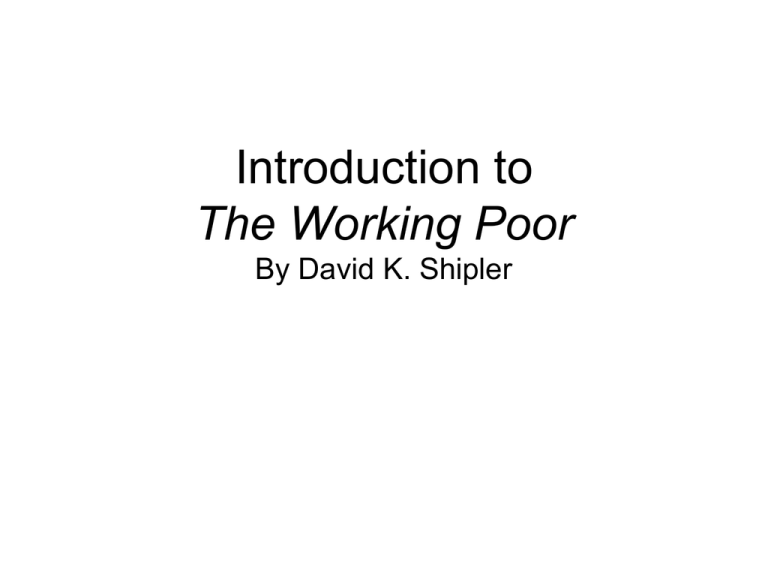Intro to Working Poor
advertisement

Introduction to The Working Poor By David K. Shipler Purpose of Book • What is Shipler’s purpose in writing The Working Poor? • Ultimate purpose of the book—to help us see the problems of the working poor. “The first step is to see the problems, and the first problem is the failure to see the people” (p. 11). What are the keys questions asked in this chapter? • Why are the Poor poor? • What is poverty? Why are the Poor poor? • The American Myth (p. 5) – “Any individual from the humblest origins can climb into well-being.” (p. 5) – Corollary: Hard work can cure poverty. – If hard work can cure poverty, then the Poor must be Poor because they choose not to work enough Why are the Poor poor? • The American Anti-Myth (p.6) – “Society is largely responsible for the individual’s poverty.” (p.6) • What does society do create poverty? Shipler rejects both myths! • “The working individuals in this book are neither helpless nor omnipotent, but stand on various points along the spectrum between polar opposites of personal and societal responsibility.” (p. 6) • “For practically every family, then, the ingredients of poverty are part financial and part psychological, part personal and part societal, part past and part present.” (p. 11) Why would Shipler choose to open his book with the question, Why are the Poor poor? • Policy implications . . . The reality I discovered does not fit neatly into anyone’s political agenda. I want to challenge and undermine longstanding assumptions at both ends of the spectrum.” (p. x) Policy Implication of the American Myth • Adherence to the American Myth requires that the US must provide opportunity for work: Society is not left off the hook!!!! Policy Implication of the American Anti-Myth Society must reform itself by: • Eliminating racial discrimination • Redistributing economic power away from profit-hungry corporations • Improving the schools that serve children from low-income homes • Winning the war on drugs Shipler’s Policy Perspective • Interlocking problems require interlocking solutions “Every problem magnifies the impact of the others and all are so tightly interlocked that one reversal can produce a chain reaction with results far distant from the original cause.” (p. 11) Shipler believes Society must help • Breaking away and moving a comfortable distance from poverty seems to require a perfect line-up of favorable conditions (pp. 4-5) – – – – – – – Set of skills Good starting wage Job with upward mobility Clarity of purpose Courageous self-esteem Lack of substantial debt Good health—no limiting addictions – Functional family – Network of upstanding friends – Appropriate help from private and/or public agencies What is Poverty? • Standard reference dictionaries disagree – Webster’s New International Dictionary: Want or scarcity of means of subsistence – Webster’s Ninth New Collegiate Dictionary: The state of one who lacks a usual or socially acceptable amount of money or material possessions Absolute vs. Relative Poverty • Absolute: inability to provide the means of subsistence--Webster’s New International Dictionary • Relative: inability to provide a standard of living shared by most members of society-Webster’s Ninth New Collegiate Dictionary – Less than half the national median income – less than 60% of the national average income Source: http://gumption.org/1993/memo/landmarks/us_income.html Illustrations of Absolute and Relative Poverty • http://www.visualizingeconomics.com/20 06/11/05/2005-us-income-distribution/ • Material World by photojournalist Peter Menzel, http://www.pbs.org/wgbh/nova/worldbalance/material.html – Compare different standards of living across countries – Would any of the families be considered absolutely poor? Measuring Poverty in the US • We use an absolute measure • For official poverty thresholds see: http://www.census.gov/hhes/www/pov erty/threshld.html • To learn how the thresholds were developed, see Shipler, pp. 9-10, and http://www.census.gov/hhes/www/poverty/o verview.html What does it mean to live in poverty? • “ . . . Poverty is not a category that can be delineated merely by the government’s dollar limits on annual income. In real life, it is an unmarked area along a continuum, a broader region of hardship that the society usually recognizes. . .” (Shipler, p. x) What does it mean to live in poverty? • To be unable to pay all your bills out of your pay check • To be hopeless • To be helpless • To have no sense of direction • To lack cultural capital--having an appreciation for and access to the arts and supportive relationships For Thursday • Bring i-clickers to class!!!! • Review Census Bureau web sites about measuring poverty – http://www.census.gov/hhes/www/poverty/threshld.html – http://www.census.gov/hhes/www/poverty/overview.html • Read the Preface and the Introduction, in The Working Poor!





